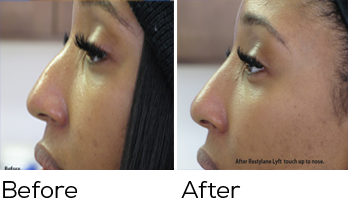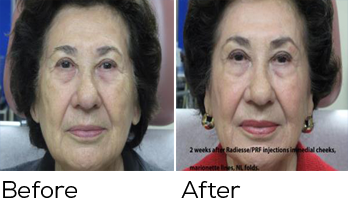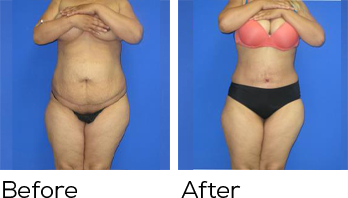Laser Skin Resurfacing
Conveniently located to serve the areas of Lake Oswego, Portland, OR and Woodburn, OR

Laser resurfacing is a technique of skin rejuvenation that leverages the precision and finesse of lasers to revive the skin. Laser resurfacing repairs the outer layer of skin, healing damage from the sun and acne scars, rebalancing pigmentation and smoothing unwanted wrinkles. Modern laser resurfacing can also initiate collagen production to offer long term benefits in tightening the skin. Lasers help us restore your youthful appearance.
Contents
- 1 Revitalize Your Skin
- 2 About Laser Resurfacing in Portland, Oregon
- 3 Benefits of Laser Resurfacing
- 4 Candidates
- 5 Your Private Consultation
- 6 Preparation
- 7 What Happens During the Procedure?
- 8 Recovery & Aftercare
- 9 Results
- 10 Other Laser Procedures
- 11 What is the Cost of Laser Resurfacing?
- 12 FAQ
- 13 References
Revitalize Your Skin
Just by living life, our skin can sustain all sorts of damage. The sun can damage our skin. Acne, chickenpox, and other afflictions can leave behind unwanted scars. Aging can leave fine lines and wrinkles where we don’t want them. Laser Resurfacing revitalizes your skin by bringing a healthy layer to the surface and activating increased collagen production, an essential ingredient in healthy skin.
Dr. Quita Lopez combines surgical expertise with a gift for understanding a patient’s needs and concerns.
A contributing expert author to a book on cosmetic surgery, she maintains current membership in 8 associations, including the Northern Oregon Medical Society. She also serves as a Committee Member on Patient Safety in the American Society of Plastic Surgeons and on the Women’s Health Committee in the American Society of Aesthetic Plastic Surgeons, among others. Dr. Lopez commits to offering both ethical and compassionate treatments. Set up an initial consultation with Dr. Lopez and discover if laser resurfacing can help you. You can reach Aesthetic Laser Center for Cosmetic Surgery at 503-353-0888.
About Laser Resurfacing in Portland, Oregon
Laser skin resurfacing, also known as a laser peel, removes the outer layer of skin. Peeling off this damaged layer will reveal a healthy layer of skin which gives you a smoother, youthful look. Laser resurfacing can reduce the damage caused by the sun as well as the fine lines and wrinkles that result from aging. Superficial scarring and uneven pigmentation can also be treated by the resurfacing procedure.
How does laser resurfacing work?
There are two basic types of laser resurfacing. Ablative lasers focus on eliminating the surface layer of the dead and damaged skin, allowing the healthy underlying support to rise to the surface. This technique is excellent at removing blotches, shallow scarring, and sun-damaged skin.[1] Nonablative lasers focus on heating the deeper layers of the skin to stimulate collagen production which tightens the skin, improves skin texture, and evens the pigmentation.[2] Some resurfacing treatments combine both methods.

Our skin consists of 64% water.[3] Current laser resurfacing technology targets that water in our skin. Laser resurfacing treatments improve your skin in two ways. First, the laser vaporizes a fine layer of the dead outer skin. Most skin irregularities and sun damage reside in this outer layer. By removing this layer, the laser renews the outer layer of our skin. Second, the laser heats deeper layers of the skin. The heating process stimulates collagen production. Collagen is a protein that helps maintain healthy skin by keeping it firm and giving it a healthy, youthful volume. We start losing collagen in our mid-20s and women in menopause can lose up to 30% of their collagen.[4]
Benefits of Laser Resurfacing
Laser resurfacing benefits for your skin occur in two stages. The first stage of benefits occurs as the outer layer of skin heals from vaporization during the initial 7-10 days. Sun-damaged or shallow scars heal and the skin is refreshed with a new layer of skin. This leads to softer skin and a reduction of fine lines and wrinkles.
The second stage of benefits become apparent over a period that may take up to 12 months. These benefits accrue as the body recreates new collagen. By heating the deeper layers of the skin, the skin activates to produce new collagen. Collagen production serves to improve elasticity in the skin, tighten the skin, and even out skin tone.
Candidates
Ideal candidates for laser resurfacing should be in good health.
Laser resurfacing can treat:
- Fine lines or moderate wrinkles
- Shallow acne or chickenpox scars
- Sun-damaged skin
- Blotchy, uneven skin pigmentation
Laser resurfacing may not be appropriate for:
- Acne that’s currently active
- Skin with very dark pigmentation
- Wrinkles that are deep
- Stretch marks
Your Private Consultation
During your private consultation, Dr. Lopez will discuss your medical history and conduct a thorough examination of your skin to determine if you qualify for laser resurfacing. Your laser treatment is highly personalized. Different skin tones are prone to varying conditions which may require or preclude certain types of laser treatments. Darker skin tones can’t be treated with ablative lasers the same way as fairer skin, but they can accept nonablative lasers. Dr. Lopez will apply her expertise in laser treatments to explore your specific case and arrive at a laser treatment plan specifically designed for your skin. Make sure to inform Dr. Lopez during your initial consultation about any medications you are currently taking or conditions you have. Connect with Dr. Lopez and schedule the first step to restoring your skin. You can reach Dr. Lopez at 503-353-0888.
Preparation
We recommend stopping any suntanning at least 4 weeks before laser resurfacing. It’s ideal to avoid sun exposure during this time but if you must venture into the sunlight then please use the highest SPF sunblock you can find. Do not have any facial peels done during this 4 week period. Follow Dr. Lopez’s specific instructions regarding any medications or other pertinent activities that you discussed during your initial consultation.
What Happens During the Procedure?
During the procedure, Dr. Lopez will use a laser device to vaporize the damaged skin on the outer layer. An undamaged layer of skin will rise to the surface. Laser resurfacing will usually take between 30 and 90 minutes, based on the parameters of the area to be treated. Most laser resurfacing procedures generally follow this order:
- Laser resurfacing can be conducted using mild sedation while awake or general anesthesia.
- Local anesthesia is applied to the facial area.
- The laser is slowly applied across the skin from the hairline to the jawline.
- A frosting appearance during laser procedure is expected for a short period, then the skin will appear uniformly red.
- Skin is cooled and the surgeon’s staff applies topical treatment such as Vaseline.
Recovery & Aftercare
Patients should expect some swelling and redness for a week or two after the resurfacing treatment. In the next day or two following resurfacing, your face will likely feel warm as if you were out in the summer sun. You should wash your face at least four times per day for the next 7-10 days. Apply Vaseline to your face after washing to keep your face moist. We recommend not leaving the house for between 1-2 weeks. After 2 weeks, you should be able to return to all normal activities.
Results
Studies indicate laser treatment benefits a variety of skin conditions that occur on the outer surface of the skin. Clinical studies show that laser resurfacing is safe and effective in treating undesirable scarring, including acne scars, with minimal adverse effects.[5] A recent survey of the pertinent scientific literature shows that nonablative lasers are both effective and safe at skin rejuvenation in skin types of color.[6]
Patients of Dr. Lopez can attest to her care in providing laser treatment.
Some patients might experience significant results from just a single session, usually with ablative laser treatment. Many patients will need more than one session to achieve the desired results. Additional touch-up treatments over the years might be needed to maintain the results.
Other Laser Procedures
If you have any unwanted hair in certain regions, Dr. Lopez also offers laser treatment for hair removal. Aesthetic Laser Center also provides laser vein treatment which reduces varicose or “spider” veins.
What is the Cost of Laser Resurfacing?
Laser resurfacing is a highly customizable treatment that depends on your skin tone, the damage you want to repair, and your end goals. During your private consultation, Dr. Lopez will provide you with upfront pricing after a comprehensive discussion and assessment of your case. Financing options through CareCredit are available if you prefer to not pay for the entire treatment outright.
FAQ
Is laser resurfacing safe?
Laser resurfacing is a safe procedure when performed by an experienced board-certified surgeon. Patients should seek a surgeon with a thorough understanding of what type of laser treatment a patient’s skin tone requires. It’s important to trust your surgeon and Dr. Lopez’s patients acn speak to her stellar reputation.
Can laser resurfacing be used on darker skin tones?
Yes, nonablative laser resurfacing can be used on darker skin. Make sure to ask Dr. Lopez and she can provide you with the most thorough information regarding which laser treatments are appropriate for your skin.
References
- Patil, U. A., & Dhami, L. D. (2008). Overview of lasers. Indian journal of cosmetic surgery : official publication of the Association of Plastic Surgeons of India, 41(Suppl), S101–S113. PMID: 20174534
- Preissig, J., Hamilton, K., & Markus, R. (2012). Current Laser Resurfacing Technologies: A Review that Delves Beneath the Surface. Seminars in cosmetic surgery, 26(3), 109–116. https://doi.org/10.1055/s-0032-1329413
- The Water in You: Water and the Human Body. (n.d.). Retrieved June 25, 2020, from https://www.usgs.gov/special-topic/water-science-school/science/water-you-water-and-human-body?qt-science_center_objects=0
- Collagen Products: Healthy or Hype? (2020, January 15). Retrieved June 25, 2020, from https://www.cedars-sinai.org/blog/collagen-supplements.html
- Majid, I., & Imran, S. (2014). Fractional CO2 Laser Resurfacing as Monotherapy in the Treatment of Atrophic Facial Acne Scars. Journal of cutaneous and aesthetic surgery, 7(2), 87–92. https://doi.org/10.4103/0974-2077.138326
- Kaushik, S. B., & Alexis, A. F. (2017). Nonablative Fractional Laser Resurfacing in Skin of Color: Evidence-based Review. The Journal of clinical and aesthetic dermatology, 10(6), 51–67. PMID: 28979657



